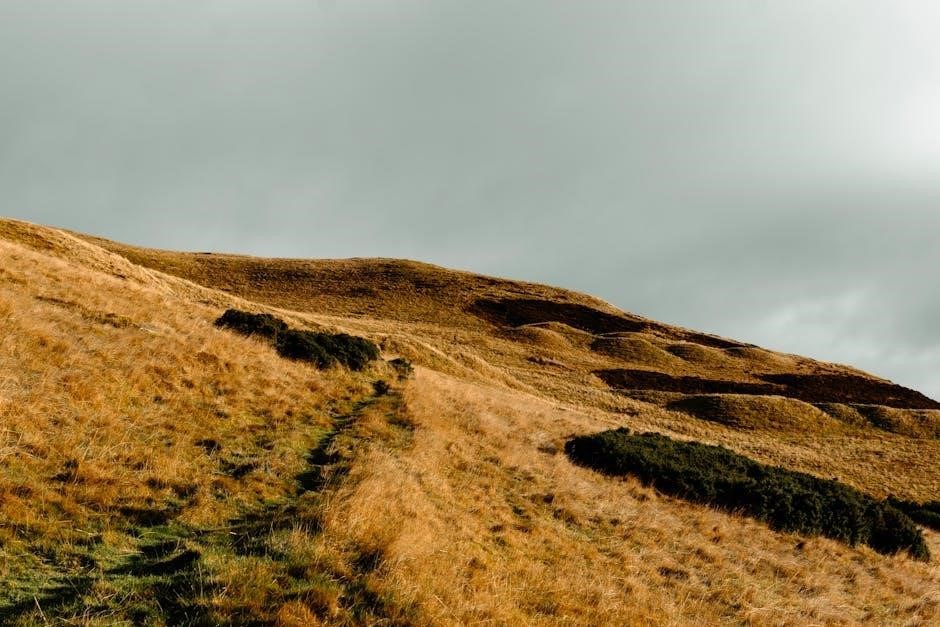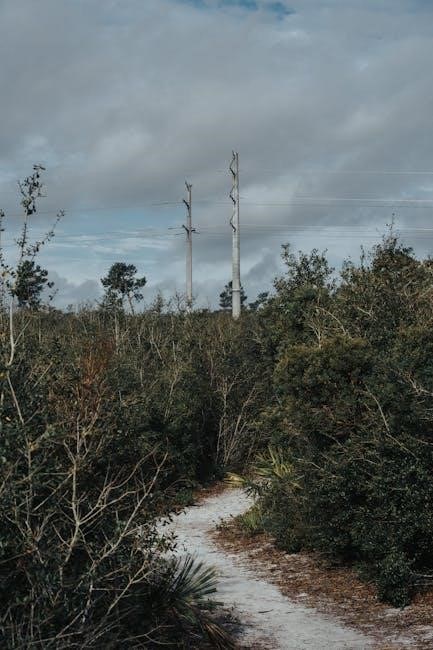A 4K trail camera offers high-resolution imaging and video capture, ideal for wildlife monitoring, security, or outdoor adventures. With advanced features like night vision and motion detection, it provides crisp, detailed footage in various conditions, making it a versatile tool for both enthusiasts and professionals.
What is a 4K Trail Camera?
A 4K trail camera is a high-resolution outdoor camera designed for capturing wildlife activity, security monitoring, or scenic observations. It records video and images in ultraHD 4K resolution, ensuring crisp and detailed footage. These cameras are typically weather-resistant, equipped with motion detection, night vision, and long battery life. They are often used in remote areas, such as forests or wildlife habitats, to monitor activity without human interference. Unlike traditional cameras, trail cameras are designed for durability and stealth, making them ideal for outdoor use. Their advanced sensors and high-quality lenses allow for clear imagery, even in low-light conditions, making them a popular choice for hunters, nature enthusiasts, and property owners.
Key Features of a 4K Trail Camera
- 4K Resolution: Captures stunning high-definition images and videos, ensuring detailed wildlife or property monitoring.
- Night Vision: Infrared or LED illumination for clear footage in low-light conditions without disturbing animals.
- Motion Detection: Triggers recording or snapshots when movement is detected, conserving memory and battery.
- Weather Resistance: Durable design to withstand rain, snow, and extreme temperatures for outdoor reliability.
- Memory Capacity: Supports large SD cards for extended recording without frequent replacements.
- Long Battery Life: Efficient power management for months of operation on a single set of batteries.
- Remote Access: Connects to apps for real-time monitoring and adjustments via Wi-Fi or cellular networks.
- GPS Tracking: Geotags images and videos for precise location data, useful for mapping animal movements.
These features combine to make 4K trail cameras versatile tools for surveillance, wildlife observation, and outdoor adventures.

Unboxing and First Impressions
Your 4K trail camera includes essential accessories for quick setup, featuring a sturdy design and user-friendly interface that simplify capturing high-quality images immediately and effectively.
What’s Included in the Box?
Your 4K trail camera typically comes with the camera unit, a detailed user manual, mounting hardware (e.g., straps or brackets), and sometimes a USB cable for data transfer. Additional items may include a memory card (check compatibility requirements) and cleaning tools to maintain lens clarity. Some packages also provide a quick-start guide for easy setup. Ensure all components are accounted for before initial use to guarantee optimal performance and functionality. Always verify the contents against the manufacturer’s list to avoid missing any essential accessories. This ensures you’re fully prepared to begin capturing high-quality images and videos right out of the box.
Initial Setup and Configuration
Unboxing your 4K trail camera, you’ll find the device, mounting hardware, and a user manual. Begin by inserting a compatible SD card, ensuring it’s formatted correctly for optimal performance. Charge the battery fully before first use. Mount the camera in a desired location, ensuring a clear view of the area you wish to monitor. Power on the device and navigate through the menu to set the date, time, and sensitivity settings. Motion detection and night vision can be enabled or adjusted based on your needs. The camera is designed for hassle-free setup, with intuitive controls and a user-friendly interface. Follow the manual’s guidance to customize settings for the best results.
Installation and Mounting
Install your 4K trail camera in a strategic location, ensuring optimal visibility. Use the included mounting strap or bracket for secure attachment to trees or posts. Adjust the angle carefully for the best field of view and ensure stability to prevent movement or vibration during use.
Choosing the Best Location for Your Camera
Selecting the right spot for your 4K trail camera is crucial for capturing high-quality footage. Look for areas with clear visibility, such as game trails or open fields, to maximize your camera’s field of view. Ensure the camera is positioned at a height that avoids obstruction from vegetation while keeping it concealed from tampering. Consider the direction of sunlight to prevent overexposure and glare. Proximity to wildlife hotspots, like water sources or feeding areas, increases the likelihood of capturing activity. Test the location by observing animal movement patterns and adjust as needed for optimal results. Additionally, ensure the camera is secure and less visible to passersby for better protection.
Mounting the Camera: Tips and Tricks
Mounting your 4K trail camera effectively is crucial for capturing high-quality footage. Start by selecting a location with clear visibility of the target area, such as game trails or watering holes. Ensure the camera is at a height that minimizes tampering and tripping hazards, typically between 3 to 5 feet off the ground. Use the included mounting bracket or a sturdy tree strap for secure attachment. For areas without trees, consider using a fence post or a freestanding mount. Face the camera north to avoid direct sunlight and glare, which can improve image clarity. Additionally, polish the camera’s contacts with a SD card-sized tag board to ensure optimal performance. Experiment with different angles and positions to achieve the best results, and check the footage regularly to adjust as needed. Secure the camera firmly to prevent movement and ensure reliable operation. By carefully considering placement and utilizing the provided mounting options, you can maximize the effectiveness of your trail camera setup.

Camera Features and Settings
A 4K trail camera captures stunning 4K resolution images and videos, equipped with night vision, motion detection, and adjustable settings for optimal storage on SD cards.
Image and Video Quality: 4K Resolution Explained
A 4K trail camera captures stunning imagery with a resolution of 3840×2160 pixels, delivering crisp and detailed visuals. This ultra-high definition ensures that both photos and videos exhibit exceptional clarity, making it easier to identify wildlife or monitor outdoor activities. The 4K resolution enhances color accuracy and dynamic range, providing vibrant and lifelike footage even in challenging lighting conditions. Whether recording during the day or at night, the camera’s advanced sensor technology optimizes image quality, minimizing noise and blur. This level of detail is particularly beneficial for analyzing small subjects or reviewing footage for surveillance purposes, making 4K trail cameras a significant upgrade over lower-resolution models.
Night Vision: How It Works
Night vision in 4K trail cameras enables capturing images or video in low-light conditions by using infrared (IR) technology. The camera emits IR light via LEDs, invisible to animals and humans, to illuminate the scene. The CMOS sensor detects this light, enhancing visibility in darkness. Advanced software processes the images to reduce noise and improve clarity. Night vision is crucial for wildlife monitoring, as it avoids startling animals with visible flashes. Most models offer adjustable sensitivity settings to optimize performance. This feature ensures round-the-clock surveillance, delivering clear and detailed nighttime footage, making it ideal for security and outdoor observation.
Motion Detection: Customizing Sensitivity
Motion detection is a key feature of 4K trail cameras, allowing them to capture activity automatically. Customizing sensitivity ensures you capture the right moments without false triggers. Adjusting the sensitivity settings can help tailor detection to your environment, whether it’s a busy forest or a quiet backyard. Higher sensitivity may detect smaller movements, while lower settings focus on larger subjects. Some cameras offer adjustable zones, letting you ignore areas like roads or fences. Testing different levels and reviewing footage helps fine-tune performance. Proper positioning and angle setup also enhance accuracy. This feature is essential for wildlife monitoring, security, or capturing rare animal behavior, making your camera more efficient and reliable in the field.
Memory and Storage: SD Card Requirements
For optimal performance, a 4K trail camera requires a high-quality SD card with sufficient storage capacity. Recommended cards include Class 10, U1, or V10 ratings, ensuring fast data writing. The camera supports SDHC and SDXC cards, with a minimum capacity of 8GB and a maximum of 128GB. To prevent data loss, format the SD card using the camera’s menu before first use. Regularly cleaning the card contacts with a soft cloth enhances reliability. For best results, use a card with a storage capacity that matches your usage needs, whether for photos, videos, or time-lapse recordings. Always backup footage to avoid data loss.

Understanding the Manual
The manual serves as a detailed guide to navigate your 4K trail camera’s features, ensuring optimal setup and usage for capturing high-quality images and videos effectively.
Navigating the User Manual
The user manual for your 4K trail camera is designed to guide you through setup, features, and troubleshooting. It typically starts with an introduction to the camera’s components and basic operations. Look for sections dedicated to installation, configuration, and advanced settings to maximize functionality. The manual often includes diagrams and step-by-step instructions for clarity. Pay attention to the table of contents or index to quickly find specific topics, such as motion detection sensitivity or memory card requirements. Tips for optimal performance and troubleshooting common issues are usually highlighted to ensure a smooth experience. By familiarizing yourself with the manual, you can unlock your camera’s full potential and resolve any challenges efficiently.
Essential Buttons and Controls
Your 4K trail camera features a straightforward control layout, designed for easy navigation. The power button turns the device on/off, while the mode button cycles through settings like photo, video, or timer modes. The navigation buttons allow you to scroll through menus and adjust settings. The OK/confirm button selects options, and the shutter button triggers image or video capture. Additional controls may include ports for SD cards, USB connections, or Ethernet for advanced setups. Familiarizing yourself with these buttons ensures seamless operation. Always refer to your camera’s specific manual for detailed button functions, as layouts may vary slightly between models.

Customizing Settings for Optimal Performance
Customizing your 4K trail camera’s settings ensures it performs optimally for your specific needs. Adjust motion detection sensitivity to reduce false triggers or increase it for capturing more activity. Set video resolution to 4K for high-quality footage or lower it to save storage space. Experiment with trigger intervals to balance capture frequency and battery life. Night vision settings can be fine-tuned for clearer images in low-light conditions. Additionally, customize time-lapse intervals or enable burst mode for capturing rapid sequences. Tailoring these settings enhances image quality, reduces unnecessary footage, and extends battery life, making your camera more efficient and effective for wildlife monitoring or security purposes.

Troubleshooting Common Issues
Common issues include connectivity problems, poor image quality, and battery life concerns. These can often be resolved by resetting the camera, updating firmware, or adjusting settings.
- Connectivity: Check Wi-Fi signal strength and ensure proper app pairing.
- Image quality: Clean lenses and adjust sensor sensitivity for optimal results.
- Battery life: Use high-capacity batteries and enable power-saving modes.
Resolving Connectivity Problems
Connectivity issues with your 4K trail camera can often be resolved by restarting the device or checking your Wi-Fi settings. Ensure the camera is properly linked to your app by verifying the network password and signal strength. If the connection fails, reset the camera to its factory settings and pair it again. Additionally, update the app and camera firmware to the latest version, as outdated software can cause compatibility problems. Physical obstructions, such as trees or buildings, may also weaken the signal. For persistent issues, consult the user manual or contact customer support for further assistance. Regularly checking and maintaining a stable connection ensures reliable performance and remote access functionality.
Fixing Video or Image Quality Issues
If your 4K trail camera is producing blurry, low-resolution, or distorted images or videos, several factors could be at play. First, ensure the SD card meets the recommended specifications and is properly formatted. A slow or incompatible card can degrade quality. Next, check the camera settings to confirm that 4K resolution is enabled and that video or image quality is set to the highest option. Dirty lenses or incorrect focus can also cause issues, so clean the lens regularly and ensure it’s free from smudges. If the problem persists, reset the camera to factory settings or update the firmware to the latest version. Additionally, avoid placing the camera in direct sunlight or behind glass, as this can cause glare or reflections. Finally, ensure stable connectivity if using remote access, as poor connections can affect image transmission quality. Regular maintenance and proper configuration are key to resolving these issues effectively.
Addressing Battery Life Concerns

Battery life in 4K trail cameras can vary depending on usage and settings. To maximize performance, use high-quality, rechargeable batteries and ensure they are fully charged before deployment. Enable power-saving features like low-battery alerts and adjust motion detection sensitivity to reduce unnecessary drain. Regularly check battery levels, especially in cold weather, as temperatures can impact performance. If issues persist, consider using an external power source or solar panel for continuous operation. Always follow the manufacturer’s guidelines for battery maintenance and avoid mixing old and new batteries. Proper care and optimization can significantly extend the camera’s operational time in the field.

Advanced Features
4K trail cameras offer advanced features like remote access via apps, time-lapse recording, burst mode for capturing fast action, and GPS for geotagging locations, enhancing functionality.
Remote Access and App Connectivity
Remote access and app connectivity allow users to monitor their 4K trail camera from a smartphone or tablet. By downloading the dedicated app, users can view live footage, receive notifications, and adjust settings remotely. This feature is particularly useful for wildlife monitoring or security purposes, enabling real-time monitoring without physical proximity to the camera. Most apps offer intuitive interfaces for adjusting motion detection sensitivity, reviewing stored images, and managing battery life. Additionally, some models support cloud storage integration, ensuring footage is securely saved and accessible from anywhere. This functionality enhances convenience and provides peace of mind, especially for cameras installed in remote locations. Proper setup typically requires a stable internet connection and syncing the camera with the app.
Time-Lapse and Burst Mode
Time-lapse mode allows you to capture images at set intervals, perfect for observing wildlife behavior over time. Burst mode takes multiple shots quickly, ideal for action photography. Both modes enhance your camera’s functionality, enabling you to capture dynamic scenes effortlessly. Configure these settings via the menu to customize intervals and frame counts. Use time-lapse for monitoring feeding patterns or seasonal changes, and burst mode for fast-moving subjects like birds or deer. These features ensure you never miss a moment, making your 4K trail camera even more versatile for surveillance and creative photography.
GPS and Geotagging
GPS and geotagging in a 4K trail camera add geographical data to your images and videos, pinpointing the exact location where each shot was captured. This feature is especially useful for tracking wildlife movements or documenting outdoor adventures. The camera uses satellite signals to embed latitude, longitude, and timestamp information into your media files. Geotagging helps in organizing your footage spatially and can be valuable for research or security purposes. Enable this feature through the camera’s settings to enhance your data collection capabilities. Ensure the camera has a clear view of the sky for accurate GPS functionality.

Security and Privacy
Protecting your 4K trail camera from tampering and ensuring footage privacy is crucial. Use password protection, data encryption, and secure physical locks to safeguard your device and recordings.
Protecting Your Camera from Tampering
To safeguard your 4K trail camera from tampering, consider using a security box or cage specifically designed for trail cameras. These enclosures protect against physical damage and unauthorized access. Additionally, install the camera in a discreet location, such as a tree with dense foliage, to reduce visibility. Use a high-quality padlock or cable lock to secure the camera to the mounting surface. Regularly inspect the camera and its surroundings for signs of tampering. For added security, enable password protection on the camera and ensure firmware is up to date to prevent hacking. Strategic placement and physical barriers are key to deterring potential vandals or thieves.
- Use a security box or cage for protection.
- Install in a discreet, hard-to-reach location.
- Secure with a padlock or cable lock.
- Enable password protection and update firmware regularly.
Securing Your Footage
To ensure your 4K trail camera footage remains safe, use a secure SD card and consider encryption. Regularly back up data to cloud storage or an external drive. Install the latest firmware to protect against vulnerabilities. Use strong passwords for app connectivity to prevent unauthorized access. For added security, enable GPS tracking to locate the camera if it’s tampered with. Physical protection, such as locking the camera, can also deter theft. Always verify the authenticity of apps and software used for data transfer to avoid malware risks. By implementing these measures, you can safeguard your footage and maintain privacy effectively while using your 4K trail camera.

Maintenance and Care
Regular cleaning of the lens and contacts ensures optimal performance. Use a soft cloth and avoid harsh chemicals. Check for firmware updates to keep your camera up-to-date and running smoothly.
Cleaning and Maintaining the Camera
Regular cleaning and maintenance are essential to ensure your 4K trail camera performs optimally. Use a soft, dry cloth to wipe the lens and exterior to prevent dust buildup. For stubborn smudges, dampen the cloth with water, but avoid harsh chemicals. Clean the memory card contacts periodically to ensure proper data transfer. Check the battery compartment for corrosion and ensure it’s dry. Store the camera in a cool, dry place when not in use. For long-term storage, remove the batteries. Polishing the contacts with a small tag board can improve connectivity. Regularly inspect the protective casing for damage and replace it if necessary to maintain weather resistance.
Updating Firmware
Regular firmware updates are essential to ensure your 4K trail camera performs optimally. These updates often improve functionality, fix bugs, and enhance compatibility with accessories. To update, visit the manufacturer’s website, download the latest firmware, and transfer it to your camera using an SD card. Insert the card, power on the device, and follow on-screen instructions. Always use a fully charged battery and avoid interruptions during the process. After completion, restart the camera to apply changes. For detailed steps, refer to your camera’s manual or manufacturer support. Keeping firmware up-to-date ensures you benefit from the latest features and improvements.
A 4K trail camera is a powerful tool for capturing wildlife or securing your property. By following this guide, you can optimize its features and performance. Regular maintenance and staying updated with firmware ensures longevity and functionality. Explore advanced modes and settings to enhance your experience and capture stunning imagery effortlessly.
Final Tips for Getting the Most Out of Your 4K Trail Camera
To maximize your 4K trail camera’s performance, ensure regular cleaning of the lens and sensors to avoid blurry images. Always use high-quality SD cards with sufficient storage to prevent data loss. Position the camera at the optimal height and angle to capture clear footage. Test the motion detection sensitivity to reduce false triggers. Utilize time-lapse and burst modes for capturing dynamic scenes. Keep the firmware updated for the latest features and improvements. Store the camera in a dry, cool place when not in use to prolong battery life. Experiment with settings like aperture priority for better image control. By following these tips, you can enhance your outdoor monitoring experience and capture stunning 4K visuals effortlessly.
Recommended Accessories
To enhance your 4K trail camera experience, consider investing in essential accessories. A high-capacity SD card (at least 64GB) ensures ample storage for 4K videos and photos. A tree mount or tripod provides stable installation in the field. For prolonged use, a solar panel kit can keep the battery charged. A weatherproof case protects the camera from harsh conditions. Additionally, a lock box or steel cable can secure the camera from theft or tampering. Finally, a carrying case makes transporting the camera and accessories convenient. These additions optimize performance, security, and ease of use, ensuring you get the most out of your 4K trail camera.